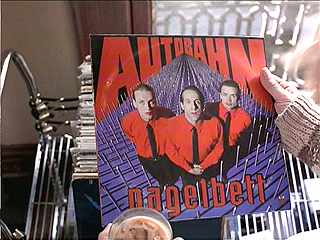[NOTE: this post originally appeared on Datachondria, a blog dedicated to technology, data, and modern life.]
We've written previously about the possible impact of digital distribution on the impulse purchase, and will have more to say in the future. But something else in the equation occured to me after a handful of particularly frustrating attempts to buy music online recently. Something that's obvious but goes unstated in discussions about preserving traditional industry practices.
I was irritated a few months ago when I placed Hjaltalín's wonderful album Sleepdrunk Seasons in my iTunes wishlist playlist, only to discover when I went back to purchase it on payday that the territorial rights had changed and it was no longer available via the Canadian store. (I was eventually able to purchase it via the record label, Kimi).
This week I have tried and failed to purchase Cliff Martinez's beautiful score to Steven Soderbergh's remake of Solaris, and -- astonishingly -- The Orb's Adventures Beyond the Ultraworld.
(And if you're looking for music which is not available on iTunes, discovering that the record label in question is a subsidiary of one of the majors is really, really bad news. Small labels appear to have discovered the benefits of having in-house mp3 stores. The majors? Not so much.)
A few years ago, this kind of thing would have been mildly irritating but not all that surprising. So your local record store was sold out or didn't carry that particular release. That's inconvenient -- but with those cumbersome industrial production processes and a physical supply chain to negotiate, it wasn't going to shake you up. You were used to it. You'd place a special order, order it yourself online and wait a few days, or just give up. Oh well. Nobody has a right to everything.
Nowadays, though, these oversights feel absolutely unforgivable -- not least because so many of the alternatives (the secondhand stores, the large independents like Sam's, the in depth assortment at large branches of HMV) have disappeared precisely because of the benefits promised by iTunes and its legal and illegal competitors.
This reminds me of something that Dustin Curtis wrote about recently on his amazingly attractive website. The customer experience is only as good as its weakest link. iTunes is an astonishingly good customer experience -- in the context of everything that preceded it -- and offers a breadth of selection unlike anything the average consumer has ever known. But when you can't get something that should be easy -- easy -- it feels as if they don't care.
And for the most part these things aren't the fault of iTunes, Amazon, or other digital retailers. Territorial rights are a massive barrier to the promise of universal availability. But there has been a sea change, I think, in customer's tolerance for a lack of product availability. In the past, it was possible that the retailer was trying but that they weren't very good. This still persists with traditional retailers (Metro, I'm looking at you). But where digital product is the norm, it doesn't feel like that's possible. Instead, it feels like the retailer isn't even trying -- that they just don't care. That's a terrible, terrible face for a major retailer to show to their customers.
As industrial production and distribution processes fade as intermediate factors between content producer and content consumer, the expectations for customer service are skyrocketing. Traditional retail spaces are being redesigned around exceptional customer service rather than stack-and-sell local warehousing. This is the wrong time to be hiding behind the walls of territorial copyright, which will only make customers feel justified in acquiring product in illegal ways. For these reasons it's encouraging to see New Zealand effectively scrap its existing copyright laws, and Australia begin to dismantle territorial copyright.
As the ebooks revolution gathers steam, this will be critical for Amazon, Shortcovers, and other contenders to bear in mind. It's all about availability and customer service. The customer will not forgive you for slamming the door in their face. They will not wait for copyright to catch up. They will sign out of the system.
Digital distribution won't level the playing field. It will tilt it in the customer's favour.

